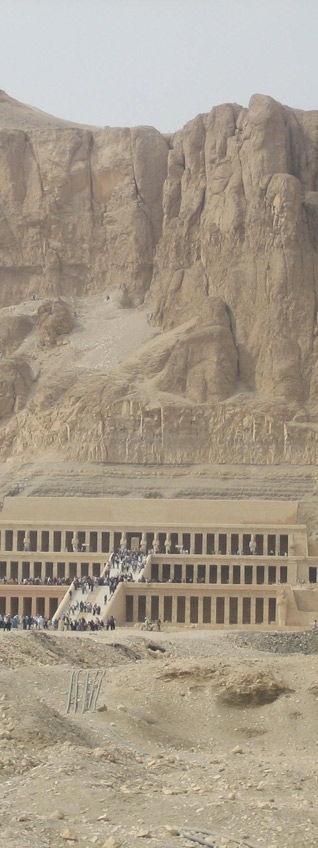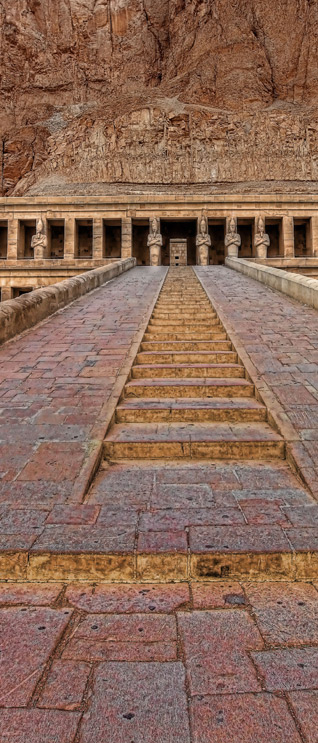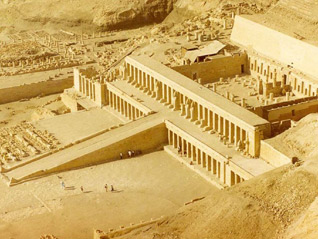Travel
The Splendour of Splendours
T. SHER SINGH
DAILY FIX
Thursday, June 21, 2012
My daughter and I learnt that religious fundamentalism - especially of the violent kind - was good for the kind of travel we preferred.
Therefore, it was not by accident that we decided to take advantage one winter of a sudden and drastic drop in tourism in Egypt because of a few hot spots around the country. We figured it would mean no crowds and no line-ups. We’d be safe, we were assured, if we skirted around the problem areas. And the best hotels were available at bargain prices.
With no need for advance reservations, it allowed us spontaneity in where we went and what we chose to do.
After a week in Cairo, we flew all the way south to the Sudanese border and then gradually made our way back towards Cairo.
Midway up the Nile, we found ourselves in Luxor, a town that now stands amidst the ruins of ancient Thebes.
Early one morning, we crossed the river, rented a car and meandered towards the hills that hide the Valley of Kings and, of course, the tomb of Tutankhamun and all those who bore the name of Ramses.
We passed through the dilapidated old village of Qurna. We stopped outside a hut and hung around an artisan carving out an alabaster bowl with a hand grinder. The driver, who came with the car, fetched us a couple of cups of chaa. We sat down and glanced through our guide book, while the artisan studiously ignored us.
Strategically placed between the Valley of Kings and the Valley of Queens, Qurna has been forever a village of grave robbers who have made their living by plundering the nearby tombs of ancient kings, queens and nobles. The book also told us that the village is populated by the descendants of the grave robbers, and they still know the hills like nobody else does, and continue to scour through them. They supplement their income with the growth industry of fake antiques.
We told our driver that we wanted to drive to Deir-el-Bahri, the Northern Monastery. Ever since we began to plan this trip, we’d been captivated by the photos and description of its temple. Built 3500 years ago by Hatshepshut, Egypt’s only female pharoah, everything we had seen and read about it matched the name she had given to it: Djeser Djeseru - the Splendour of Splendours.
It was the mental image of this temple - not the pyramids or the treasures of King Tut - that had haunted us for months. Its expansive and timeless beauty, appearing eerily modern, not unlike a Frank Lloyd Wright creation, overwhelmed us: a pearl in a shell encased in the towering cliffs behind it.
It was this lure that had brought us to Egypt.
The driver, sensing our excitement, had a suggestion. Instead of driving us to the main approach to the massive complex, he could take us in the opposite direction to a neighbouring village, Deir-el-Medina, and drop us at the end of the road, where the hills began.
Walk through the hills, he said, it won’t take more than an hour, and you will suddenly see the ampitheatre of the valley of the Temple of Hatshepshut sprawling way below you.
It’s a sight to behold, he said, which very few people get to experience. At the very first sight, you’ll drop down to your knees and want to pray …
My daughter and I looked at each other. We had our knapsacks and our supply of water and food. She had her Blue Jay baseball cap to fend off the onslaught of the sun. Our hiking boots could handle the rough terrain.
But how would we find our way? Are there any signs? No, he said. But the path is easy to follow; the donkeys use it all the time. And so do the villagers when looking for a short cut. Is it safe? Oh yeah, he assured us; you won’t see a soul this time of the day.
His enthusiasm was catching.
Sure, we said with our heart, while the brain screamed, NO, NO! We ignored the warnings.
He dropped us off in the middle of nowhere, pointed us eastwards to what vaguely looked like a path, and yelled out: “Keep to the left when you get to the fork. See you at the temple in two hours!”
And drove away.
* * * * *
It is harsh and barren. The white haze of dry air makes everything look gold and brown. A tinge of blue in the canopy of the open sky. The earth is powdery.
A few minutes into the pathway, my daughter turns around and stares at me. Her eyes say it all: “We might as well be on Mars, you know.”
It translates into “If something goes wrong, it’ll go terribly wrong!” in my mind. I try to drive away all the fears that appear, one by one, with pre-programmed intensity. A little late for these thoughts, I scold myself, and push them away.
Somehow, I manage to enjoy it all as we trudge on in silence. I try and imagine this very scene, the sights and sounds and smells of when Hatshepshut ruled the land millennia ago.
An hour later we stop and drink some water.
Did we pass the fork? We haven’t seen a soul since we began. We reassure ourselves that we’ll be fine. We rest though there is no shade or greenery. I pull out my guide book and find the description of the path down the final hill on the approach to the temple.
Suddenly we see a man staring down at us from a hillock about 50 feet away. A local, it is obvious from his attire. He comes down and greets us. We start a conversation made up entirely of single words. When I run out of my limited Arabic, I throw out Urdu words until he recognizes one and nods or shakes his head in reply.
Yes, he says, we are on the right path. Only 20 minutes away.
Are we Arab? No, I tell him. Muslim? No, Sikh, I tell him. Nehru? I nod. Yes, he‘s made the connection. America? No, Canada. “Canada Dry!” he proclaims triumphantly, and breaks into a toothless smile..
He parts his abayeh robe and pulls out a bundle from his waist. Sits down on his haunches, places it on the ground and slowly rolls it open.
“Antika,” he says.
Little statuettes of ancient gods and goddesses lie on the rag, staring up at us solemnly.
No, I say.
Cheap, he says.
No, I say.
How much, he says.
No, I say.
My daughter and I grab our knapsacks and sling them over our shoulders, indicating that we are heading on. He gives us a resigned look, rolls up his wares and tucks the bundle back into his waist.
We wave at each other and head out in opposite directions.
Minutes later, we hear hurried footsteps behind us. We swing around: it’s him again. Breathless.
Wait! he motions, as he catches his breath. He fumbles inside his cloak and digs out the bundle again. No, no, I implore. He unravels it again on the ground.
He points at my daughter.
“Your child?”
I nod.
He smiles.
With gestures and grunts, he tells us he too has a daughter. Same height. Just like her, and he points to my daughter. He looks at her.
He points to the bundle. Take one, he says.
N-O, I say.
No, she says.
Yes, take one, he says. From me, from my daughter to you. No money. Egypt, he says and puts his hand on his heart. Canada, he says, and points to us.
No, we say.
He is stubborn. He says he won’t go unless she takes one.
She reluctantly picks one, a lovely little clay doll.
I feel defeated. I take out my wallet to pay him anyway.
No, no, he says. Daughter, he says.
He hurriedly rolls the bundle, puts it away, and briskly walks away. I call out after him, asking his name. But he’s turned around a corner. He’s gone. We never see him again.
Twenty minutes later, the hills part before us and the splendour of the Temple of Hatshepshut unfolds before us, a mile or so below.
A quiet descends on us. We sit down by the cliff side.
It feels good to be alive.
Conversation about this article
1: Sangat Singh (Kuala Lumpur, Malaysia), June 21, 2012, 9:35 AM.
Sher ji, you have winged me back to Tagore's Kabuliwala who looked at Ghenna like his own daughter in the far off country. Thanks for the spark to light up those memories. The gift he gave was priceless and undoubtedly the highlight of your trip. "Baal kanniaa kou baap pi-aaraa bhaa-ee kou at bhaa-ee." [GGS:549.2] "There is a very special bond between daughter and father."
2: Baldev Singh (Bradford, United Kingdom), June 21, 2012, 7:34 PM.
Blimey! Gripping stuff! The Temple in this article is an awesome 'must visit'!






